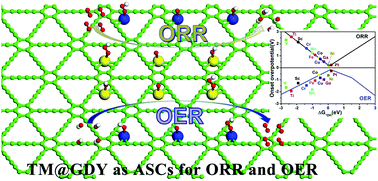Molecule-level graphdiyne coordinated transition metals as a new class of bifunctional electrocatalysts for oxygen reduction and oxygen evolution reactions†
Abstract
Single-atom catalysts (SACs) are highly desired for maximizing the efficiency of metal atoms and can entail high selectivity and activity. Bifunctional catalysts enable higher performance and lower cost than two single-function catalysts. Supported single-atom bifunctional catalysts are therefore of great economic interest and scientific importance. Density functional theory calculations are used to design SACs, isolated transition metal anchored on graphdiyne (TM@GDY), for oxygen reduction (ORR) and oxygen evolution (OER) reactions in alkaline media. A dual-volcano plot is constructed to thoroughly describe and predict the catalytic activity toward ORR and OER processes on TM@GDY materials. The results demonstrate that GDY could provide a unique platform for synthesizing uniform SACs with high catalytic activity toward ORR and OER. The theoretical evaluations show that Ni@GDY and Pt@GDY catalysts possess comparable electrocatalytic activity for ORR and OER in alkaline media. The study not only provides deep insights into the catalytic activity of TM@GDY, but also guides the design of GDY based SACs.



 Please wait while we load your content...
Please wait while we load your content...